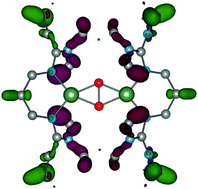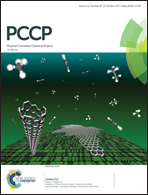Relativistic effects at the Cu2O2 core – a density functional theory study†
Abstract
This work presents for the first time the impact of relativistic effects on the Cu2O2 peroxide dicopper(II)-bis(μ-oxo) dicopper (III) equilibrium bonding motif in existing tyrosinase model complexes [Cu2(btmgp)2(μ-O)2]2+ and [Cu2{HC(tBuPz)2Py}2(O2)]2+ [S. Herres et al., Inorg. Chim. Acta, 2005, 358, 1089; S. Herres-Pawlis et al., Eur. J. Inorg. Chem., 2005, 3815; A. Hoffmann et al., Angew. Chem., Int. Ed., 2013, 52, 5398]. We use density functional theory (TPSSh/cc-pVTZ+D3BJ) with various relativistic approaches (ECPs, DKH, ZORA) to tackle the question of impact and find, as already known for small model complexes in the literature, that the O core is more stabilized with respect to the P core by the relativistic influence [D. G. Liakos and F. Neese, J. Chem. Theory Comput., 2011, 7, 1511]. Whereas DKH and ZORA yield similar results, ECPs underestimate the predicted effect. By calculating the functional of the relativistic overlap change, we can exactly identify the relativistic changes at the molecular orbital level and narrow down the affected MOs. Thus, by performing a detailed bond analysis utilizing the overlap population, we are able to rationalize the effects at the chemical level by finding relativistic bond stabilization in both isomers, which is more dominating in the O core. In conclusion, relativistic effects already play an important role in dicopper cores and should be considered.



 Please wait while we load your content...
Please wait while we load your content...